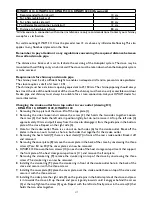
46
F
IrIng
In
general
Rapid or fierce heat
Rapid or fierce heat is obtained by burning many small pieces of wood.
Maximum amounts of fuel:
The maximum allowed amount of fuel per hour is:
Wood: 2.0 kg
If these limits are exceeded, the stove will no longer be covered by the factory guarantee, and it may also
become damaged due to excessive heat. The stove has been approved for intermittent use.
Typical re-firing interval
Typical re-firing interval at nominal performance
Wood: 65 min
Long burning times
For the slowest possible combustion, turn the regulator counter-clockwise (to the left). By turning the
regulator all the way to the left, the stove receives no primary air (the air that comes through the grate).
The stove cannot be lit after a new firing without the regulator being turned to the right, which allows
primary air to enter the unit.
If the regulator is turned 45º from its minimum position (i.e. set at 25% capacity), the stove can restart
following a new firing without further adjustment.
Insufficient firing
If the fireproof materials in the combustion chamber are blackened after a fire, then the stove is polluting,
and the Autopilot system is malfunctioning. Therefore, more air must be supplied by turning the regulator
clockwise (to the right). It may also be necessary to burn more wood.
How to achieve the best combustion
• Use clean and dry wood.
Wet wood results in inefficient combustion, plenty of smoke, and soot. Furthermore, the heat will dry
the wood, not heat up the room.
• The fire should only be stoked with a little wood at a time.
You achieve the best combustion by starting up a fire often and using only a little wood. If you use
too much firewood, it will take some time before the temperature reaches a level where you achieve
a good combustion.
• Make sure there is the right amount of air.
You should also make sure that there is plenty of air – especially in the beginning - so the temperature
in the wood burning stove climbs quickly. In this way the gasses and particles released during the
combustion will be consumed by the fire. Otherwise they build up soot in the chimney (constituting
a chimney fire risk) or will be released in a non-combusted state into the environment. The wrong
amount of air supply creates inefficient combustion and a modest effect.
• Don’t savour the fire during night time
We advise against adding fire wood to your stove and reducing the air supply at night in an attempt to still
have some embers left in the morning. If you do so, large amounts of hazardous smoke will be emitted, and
your chimney will be exposed to unnecessarily large amounts of soot with the risk of a chimney fire.
Cleaning the glass
We recommend wiping the glass after a fire. This is best done using a paper towel.
Summary of Contents for 3110
Page 2: ...2 ...
Page 4: ...4 B C A D 11 12 14 14 15 3 1 1 4 45 4 3 2 1 9 11 10 17 1 6 5 7 8 2 3 15 4 16 4 3 14 12 13 ...
Page 5: ...5 F 6 2 1 3 4 5 G 3 0 E 1 ...
Page 6: ...6 1 6 6 7 4 5 9 8 2 3 H1 10 10 11 ...
Page 7: ...7 H2 ...
Page 8: ...8 K ...
Page 50: ...50 ...
Page 51: ...51 ...
Page 52: ...52 ...
Page 53: ...53 ...
Page 54: ......
Page 55: ......











































